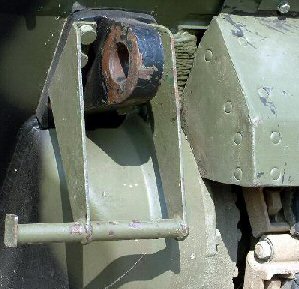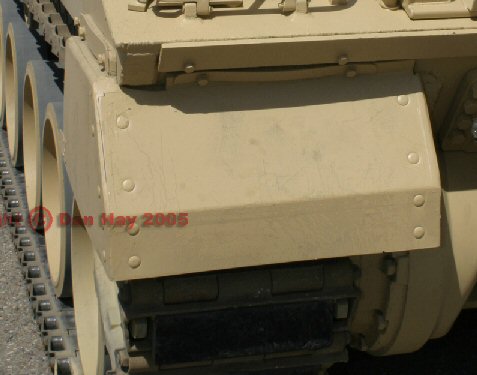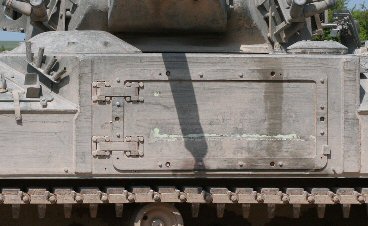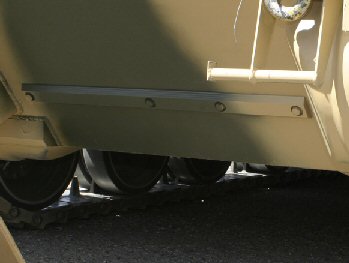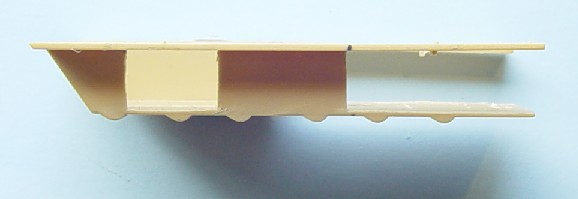|
With the release of the Revell Warrior and later the Up Armoured version, there was finally something to go with the Revell Challenger 1 and the later Dragon and Trumpeter Challenger 2 vehicles. Whilst the Revell Warrior is very good in terms of moulding and fit, there are a few details that could be made better. With the unfortunate pass over to new owners of the site some of these pages went missing, the good thing is that in between then and now new information has come to light, so giving me a chance to bring the article right up to date with the latest versions currently deployed in Afghanistan. The aim of this article is to show how to bring the Revell kit up to spec. I will also show some of the various upgrades available from CMSC and PDI Model Supplies, and the Extratech PE set, along with their faults, as well as the faults in the original Revell kit and how to correct these and what needs to be added. I daresay that some are pleased with the Warrior as it is. For those this article is not meant to deride anyone, as it always depends on your area of interest as to what you find acceptable in a model, and the more a model encroaches on your area of interest the more faults you find. For me I find that with WW2 and earlier I am prepared to accept faults easier than with Modern British and Russian vehicles. For others it will be the other way round and there will be those with a completely different point of view. For those that are interested you can incorporate as many, or as few, of the changes as you wish, as some will be time consuming and, for the want of a better word, fiddly. Before proceeding further, please first read my following warning. The more I got into modifying the Warrior
and correcting the major faults the more I started finding things
that were wrong, and to correct all the faults would mean practically
a total rebuild. Of course there are parts of the kit that can be
modified to meet the requirements, but if planning to build more
than one vehicle, the only way is to modify one part and copy
it in resin for the others. At the end you would be left with very little
plastic. What is wrong with the kit? Well, actually quite a bit, some of it is due to the molding process (i.e. to be able to release the model from the mould) and some of it is due to research errors. There are other parts that are entirely cosmetic but add to the model as a whole. Moulding process errors 1. Most of the access hatch hinges on the upper hull are vertical, where as they should be at 90 degrees to whichever plate they are on. Most noticeable of these are the front plate hinges and the drivers side plate. 2. The rear troop compartment hatches have solid hinges, instead of a bar. 3. The rear troop compartment periscopes have the incorrect profile, as does the one between the commander and gunner in the turret roof. Research errors (missing or incorrect details), in no particular order 1. Rear stowage bins are too short. 2. Left hand side access panel just behind the driver is too deep. 3. Turret periscopes are the incorrect shape. 4. Raven sights for the main gun are incorrect in shape and height. 5. Armoured deflector for the engine louvers is too small. 6. Smoke discharges (need I say more?) these seem to be the one thing that Revell consistently mess up on British vehicles (e.g. Challenger 1). 7. Gun mantlet too narrow and missing detail. 8. Lip missing from front of turret. 9. Final drive housings too wide. 10. Air intake cowl too shallow. 11. Incorrect mesh alignment shown on turret and hull baskets. 12. Missing or poorly depicted smaller lifting eyes on turret and hull. 13. Incorrectly placed fire extinguisher on the rear door. 14. Incorrectly shaped roof vent. 15. Rear door hinges too big. 16. The hull sides are not deep enough. 17. Wheels not deep enough. 18. Final drives too small in depth. Up armoured Warrior As above with the following additions. 1. Side armour panels too thin. Also the armour stands too far away from the hull sides. (Interestingly the stand off distance and the thickness of the panel would be the correct depth for the real panels, thus by adding plastic to the rear to cover the rear of the panels, the correct thickness can be achieved, although, by doing this you will need to reshape the front and rear portions of the panels, but more on this later). 2. The front glacis armour is totally wrong, firstly the top armour block is the wrong shape and doesn't extend up the glacis far enough. The bottom part is compounded by the fact that the final drives are too large, this makes both the front bin and the armour too narrow. 3. No mounting brackets for the armour depicted. CMSC Parts 1. The side armour provided by the CMSC set is the wrong size. The individual panels are too big (wide) and although the correct number of panels are depicted, because of the size the right hand side is about 1 complete panel too long. This pushes the front too far forward on the right hand side, obscuring the drivers view. The left hand side panel is also too long but not as extreme. Also the individual panels in each side are all different sizes (whereas most should be the same size, except for the obvious panels that are of a different shape and size). Here the Revell kit has the correct size of panel (if not depth). 2. The frontal armour, although of the correct size for the top, the lower armour suffers from the same fate as the Revell kit due to the oversize of the final drives. Also the frontal armour is at an incorrect angle and should be at a much sharper angle. 3. No mounting brackets for the armour depicted. The Corrections and build Lower hull The lower hull can be built as per the instructions, the only thing needed is to drill out the holes in the sprockets as well as the two holes in the centre track return roller, both of which will improve the overall look of the vehicle. It would be worth painting and weathering the track units at this stage before they are fitted to the hull to provide easier access to a lot of the running gear. Overall weathering can be done later once the kit is built, to bring it all together. The following pictures show weathered wheels and track units before being attached to the hull. Before attaching the wheels and tracks drill out the holes in the tub that make the locations for the side skirts front and rear covers. This will become apparent later as to why.
The first change that needs to be made to the lower hull are the final drives, which need to be cut down in size. This is a fairly easy process, done by removing approx. 1mm of plastic from the inner edge of the final drive housing where they meet the track assembly. This way none of the detail of the final drive housing will be lost. The end of the housing should extend along the lower plate as far as the end of the towing eye mounts. The following pictures show from where the plastic needs to be removed and how far the drives should reach. Really the final drives are too small
The towing eye mounts need to be altered, as they need to extend down to the final drive housing and 8 bolts (4 either side) need to be added. This only needs to be done to the right hand side if fitting the front armour. If the armour is not to be added then the left hand side also needs to be extended and bolts added at the same time.
Under the right hand final drive a piece of plastic needs to be added. This is presumably part of the first road wheel suspension housing. If the side skirts are to be fitted, or just the front or rear portions, the four small rivets need to be added to the edges both on the front face and on the sides of the front and rear track covers.
For the Bold and the Brave Now we come to a conundrum. The model's sides are too shallow and the fix unfortunately it is not as simple as building new sides. The problem not only lies in the depth of the sides, but also in the track units. The kit tracks are too thin and although some of the thickness can be made up by attaching new rubber pads and new longer guide horns, the tracks are also too close to the hull in more ways than one. The main tub of the kit should be wider forcing the track units out to be almost inline with the hull sides. The only way to fix this is to add plastic between the track units and the tub walls which will need some creativity to hide the fact at the front and along the bottom, but not so much at the rear, as there is missing detail which can be added to cover this. (see hull corrections). The problem lies unfortunately not only in the top hull, although it does contain the sides, but in the bottom tub and the tracks as well. The distance between the tracks and the hull is too great and you can't cut down the track units without it affecting the whole bottom unit as that would affect the height, and the height of the hull roof is more or less the correct.
So how to fix it To do this you will need 4 strips of plastic, 2 strips need to be 7.5mm wide, the others 9mm. Both strips need to be 0.5mm thick and 83mm long. One of each size now needs gluing together, one on top of the other, so that one side is parallel and the other side forms a lip. This combined strip then needs gluing to the underside of the sponsons after the wheels, with or without tracks, have been fitted. This not only reduces the distance between the hull and the track, but also deepens the hull top when it is fitted. These measurements should also give a slight overhang along the side, front and rear, even when the hull top is fitted. The fix also alters the rear bins and certain other fittings but also fixes some other problems that would otherwise prove difficult. But then it also presents other problems that are harder to fix, one of these being the NBC housing door. As it is in the kit, the housing door is too shallow, but is not noticeable because of the incorrect hull depth. Correcting the hull depth will now expose the shallowness of the door. Correcting the door will require surgery, by cutting the door length wise and inserting a plastic shim to correct the depth, however most of the detail will need to be replaced. The door can then be replaced using the two strengthening strips, as on some models these extend all the way down, thereby covering any joins. Later models On later models without add on armour, there is a noticeable strip with bolts between the final drive housings used for the mounting of the add on armour.
One thing to note for the more adventurous of you, is that if you plan to build an interior, and there are many good photos on the web to help you achieve this, you will need to remove some plastic from the hull tub before attaching the track units. This is because the hull tub takes up internal space, which would make the interior too narrow. This is one of the problems with the PDI interior. To try and regain the illusion of space, PDI have made the seats very narrow, for anyone but a midget to sit on. The following photo show where the plastic needs to be removed from. The forward portion is for the driver.
|


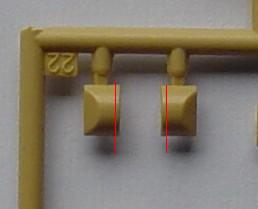 <== Cuts to the final drives
<== Cuts to the final drives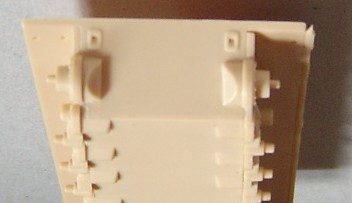 <== Position
of Final Drives on the model
<== Position
of Final Drives on the model